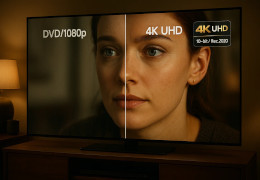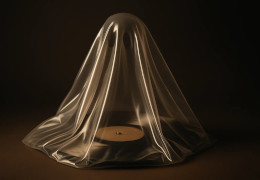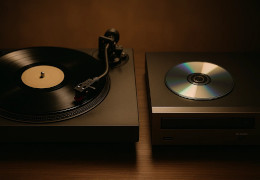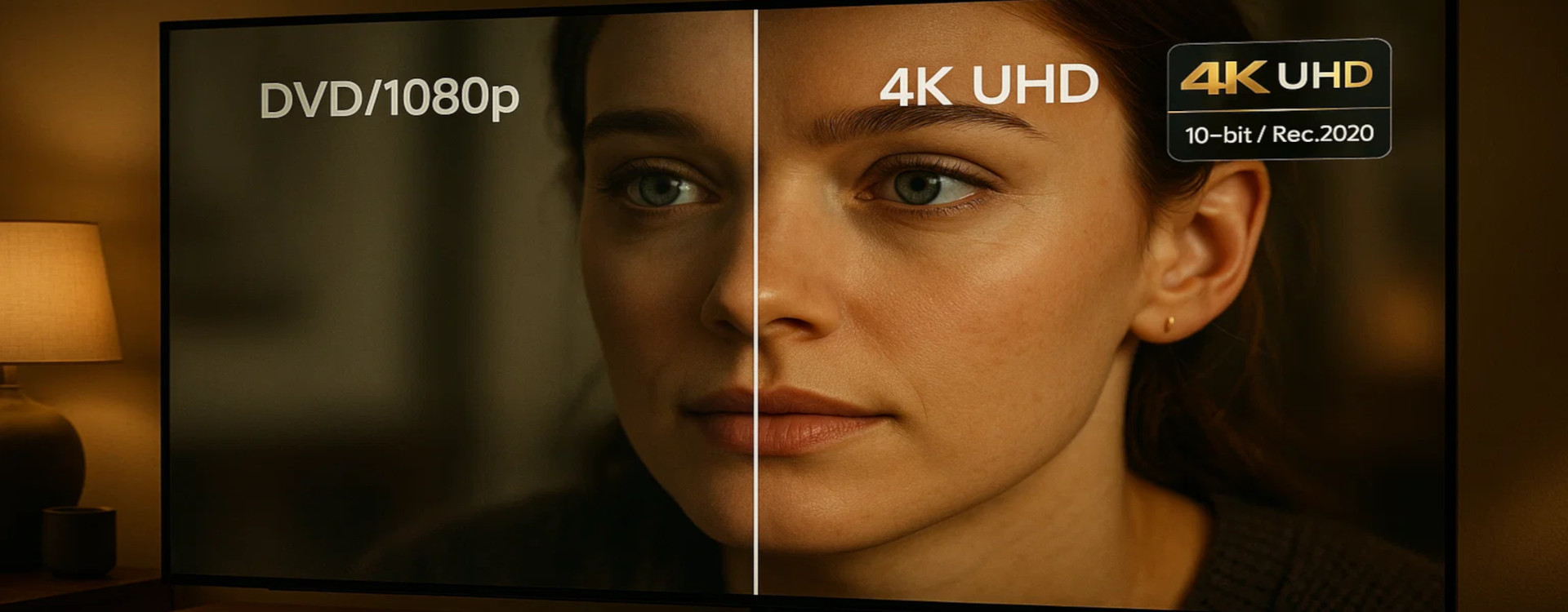DVD, 1080p, 4K, 4K UHD & “4K Restoration”: the differences made easy (with Dolby/DTS)
You’ve seen “4K Restoration”, “4K UHD”, “4K ULTRA HD” and wondered what really changes compared to DVD or 1080p. This guide explains resolution, HDR, colour, bitrate, viewing distance—and the audio side (Dolby/DTS)—so you can pick the right format for your screen and setup.
1) Video basics: resolution, compression, colour
- DVD: standard definition (SD). Historically 576i/p (PAL) or 480i/p (NTSC). Typical codec: MPEG-2 at low bitrate. Limited colour space, no HDR.
- 1080p (Blu-ray “Full HD”): 1920×1080 progressive. Modern codecs (AVC/VC-1) with far higher bitrates than DVD. Colour space Rec.709, no HDR on standard Blu-ray.
- 4K/2160p: 3840×2160. 4K UHD/4K ULTRA HD on disc (UHD Blu-ray) uses HEVC (H.265), very high bitrates, HDR (usually HDR10; often Dolby Vision or HDR10+), 10-bit depth and wider colour (DCI-P3/Rec.2020).
- “4K Restoration”: not a format but a process. The film (on photochemical stock) is scanned and restored at 4K or higher; the result may be released on 4K UHD, 1080p Blu-ray or streaming. A great 1080p sourced from a proper 4K restoration can beat a poor 4K master.
Bottom line: moving up the ladder adds detail, dynamic range (HDR), colour depth and fidelity—provided your hardware and the mastering are up to scratch.
2) 4K, 4K UHD & 4K ULTRA HD: what’s in a name?
In consumer language these are used interchangeably. Technically:
- 4K: ~4,000 horizontal pixels; in home video it almost always means 3840×2160 (UHD).
- 4K UHD / 4K ULTRA HD: consumer labels for 3840×2160. UHD Blu-ray = the physical 4K disc with HEVC, HDR, 10-bit, etc.
On a product page, check whether “4K” refers to a true UHD disc, a 4K stream, or simply a restoration mastered to 1080p.
3) HDR, bit depth & colour gamut: why 4K UHD pops
- HDR (High Dynamic Range): more detail in shadows/highlights, more lifelike colours. Common standards: HDR10 (baseline, static), Dolby Vision and HDR10+ (dynamic, scene-by-scene). A well-graded HDR can matter more than resolution alone.
- 10-bit: smoother gradients vs 8-bit (less banding in skies, more natural skin tones).
- Wider gamut: from Rec.709 (Blu-ray) to DCI-P3/Rec.2020 (UHD). More reproducible colours, less “washed-out” look.
Note: you need an HDR-capable display and correct settings. On an SDR display, the HDR advantage disappears.
4) Bitrate & compression: why discs still beat streaming
Physical discs offer much higher bitrates than streaming. The payoff: fewer compression artefacts, finer detail retention, film grain that looks organic. With the same master, a well-authored UHD Blu-ray typically outperforms its 4K stream counterpart.
5) When do you actually see the difference? (screen & distance)
- Small screens (<40") at long distance: 1080p vs 4K may look close. Prioritise good calibration and HDR support if available.
- 55–65" TVs at living-room distance: 4K/HDR is clearly visible, especially with strong restorations.
- Projectors/home cinema: 4K UHD is a significant jump (resolution + HDR + colour). Mastering quality becomes critical.
6) “4K Restoration” vs 4K UHD edition
- 4K Restoration: high-res scan of negative/interpositive, digital clean-up, colour grading. It’s the source.
- Release path: can be UHD 4K, 1080p Blu-ray or streaming. A genuine 4K-restored 1080p will still eclipse old HD/SD masters.
- Upscaled UHD: many modern films have a 2K digital intermediate. The UHD may be an upscale, but HDR/colour can still make it worthwhile. Not “fake 4K”, just not native 4K.
7) Audio: the Dolby & DTS families explained
Dolby
- Dolby Digital (AC-3): lossy, common on DVD/TV. Solid but compressed.
- Dolby Digital Plus (E-AC-3): more efficient lossy; widely used in streaming. Can carry Dolby Atmos (with metadata) in a lighter form.
- Dolby TrueHD: lossless. Common on Blu-ray/UHD. Also carries full-fat Dolby Atmos (object-based) as an extension.
- Dolby Atmos: object-based; adds height and precise 3D placement. Delivered via TrueHD (discs) or DD+ (streaming).
DTS
- DTS (Core): legacy lossy codec; generally higher bitrates than AC-3 but still compressed.
- DTS-HD High Resolution: high-bitrate lossy on some Blu-rays.
- DTS-HD Master Audio: lossless, the DTS counterpart to TrueHD.
- DTS:X: object-based (Atmos rival), 3D audio with height rendering if your setup supports it.
Which sounds better? It depends on the mix, mastering and your system (AVR/speakers/placement). As a rule: lossless tracks (TrueHD, DTS-HD MA) deliver more finesse than DD/DD+ or DTS Core. Atmos/DTS:X add vertical space if you have height speakers or a compatible soundbar.
8) Pros & cons: which format to choose—and why
| Format | Pros | Cons | Best use case |
|---|---|---|---|
| DVD | Cheap, universal compatibility, often the only edition for niche titles | SD only, no HDR, limited detail, often lossy audio | Entry collections, rare titles, small TVs, tight budget |
| Blu-ray 1080p | Big jump over DVD; high detail; often lossless audio | No HDR; Rec.709 colour gamut | TVs up to ~55", longer viewing distances, great restorations not available in UHD |
| UHD Blu-ray (4K) | Top consumer quality: 2160p, HDR, 10-bit, wide colour, premium audio | Higher price; needs HDR-capable display and UHD player | 55"+ screens or projection; you want the best picture & sound |
| 4K streaming | Convenient, instant, often with Dolby Vision/Atmos | Lower bitrates; variable quality; depends on internet bandwidth | Everyday viewing, when discs don’t exist, or as a preview |
9) Quick buyer’s checklist
- Is it a true UHD Blu-ray? (UHD logo, HDR listed, HEVC codec)
- 4K restoration or upscale? (check label/notes)
- HDR formats: which does your TV support? (HDR10/Dolby Vision/HDR10+)
- Audio tracks: lossless (TrueHD/DTS-HD MA)? Atmos/DTS:X available?
- Screen & distance: on small TVs, HDR/colour may matter more; on big screens/projection, resolution + HDR shine.
- Edition quality: extras, subtitles, region codes, authoring reputation.
10) Glossary
- SD / HD / 4K
- Standard/High/Ultra-High Definition: ~576/480, 1080, 2160 vertical lines.
- HDR
- High Dynamic Range: greater luminance range, richer colours.
- Bitrate
- Data per second: higher = fewer artefacts, cleaner image.
- Rec.709 / DCI-P3 / Rec.2020
- Colour spaces: Rec.709 (Blu-ray); P3/Rec.2020 (UHD with wider gamuts).
- Lossy / Lossless
- Compression with/without data loss (DD, DD+, DTS vs TrueHD, DTS-HD MA).
- Object-based audio
- Atmos/DTS:X place sounds in 3D space (including height) rather than fixed channels.
FAQ
- Is 4K always better than 1080p?
- Usually yes—but you need a solid master and a capable display. On small, distant screens the gap can shrink; HDR often impacts more than resolution alone.
- Does “4K Restoration” mean a 4K disc?
- No. It’s the process. Releases can be UHD, 1080p or streaming. Mastering and encoding quality are what matter.
- Dolby or DTS: which should I prefer?
- Depends on the mix. In general, lossless formats (Dolby TrueHD, DTS-HD MA) outperform lossy. Atmos/DTS:X add height if your system supports it.
- Do I need new cables?
- For 4K HDR at 60 Hz and Dolby Vision, use certified High Speed/Ultra High Speed HDMI—especially for long runs.
Conclusion: the “best” format is the one right for you
For convenience: 4K streaming. For absolute A/V quality: UHD Blu-ray. For value and catalogue depth: 1080p Blu-ray. DVD still matters for rare titles or tight budgets. Whatever you pick, verify the restoration, HDR and audio tracks: that’s where great editions separate from average ones.

















